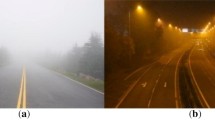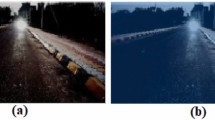Abstract
Driving at night becomes risky due to the lack of sufficient light. Drivers are unable to notice objects, potholes, pedestrians on road prominently using headlights. Low light at night causes many road accidents and road fatalities. This article presents a real-time fast, low-light vision enhancement technique for drivers. By the proposed technique a driver can have a prominent real-time bright vision of the road and surrounding view at night which appears the same during the daytime. Drivers can easily differentiate objects, potholes, and pedestrians on the road. The proposed approach is based on the modified bright channel prior, and adaptive gamma correction. The proposed approach aims to provide a real-time bright vision for drivers during the night within a minimum computation time using a low-cost 2D camera. Many real-time experiments which are conducted reveal that the proposed approach accomplishes auspiciously against state-of-the-art low-light image enhancement algorithms.











Similar content being viewed by others
References
Acharya A, Giri AV (2020) Contrast improvement using local gamma correction. In: 6th international conference on advanced computing and communication systems (ICACCS), Coimbatore, India, pp 110–114
Gu K, Lin W, Zhai G, Yang X, Zhang W, Chen CW (2017) No-reference quality metric of contrast-distorted images based on information maximization. IEEE Trans Cybern 47(12):4559–4565
Gu K, Tao D, Qiao J, Lin W (2018) Learning a no-reference quality assessment model of enhanced images with big data. IEEE Trans Neural Netw Learn Syst 29(4):1301–1313
Gu Z, Chen C, Zhang D (2018) A low-light image enhancement method based on image degradation model and pure pixel ratio prior. Math Probl Eng 9:1–19
Guo X, Li Y, Ling H (2017) LIME: low-light image enhancement via illumination map estimation. IEEE Trans Image Process 26(2):982–993
Hsieh PW, Shao PC, Yang SY (2020) Adaptive variational model for contrast enhancement of low-light images. SIAM J Imaging Sci 13(1):1–28
Huang SC, Cheng FC, Chiu YS (2013) Efficient Contrast Enhancement Using Adaptive Gamma Correction with Weighting Distribution. IEEE Trans Image Process 22(3):1032–1041
Kim W, Lee R, Park M, Lee S (2019) Low-light image enhancement based on maximal diffusion values. IEEE Access 7:129150–129163
Ko S, Yu S, Kang W, Park C, Lee S, Paik J (2017) Artifact-free low-light video enhancement using temporal similarity and guide map. IEEE Trans Ind Electron 64(8):6392–6401
Lee H, Sohn K, Min D (2020) Unsupervised low-light image enhancement using bright channel prior. IEEE Signal Process Lett 27:251–255
Li M, Liu J, Yang W, Sun X, Guo Z (2018) Structure-revealing low-light image enhancement via robust retinex model. IEEE Trans Image Process 27(6):2828–2841
Lv F, Lu F, Wu J, Lim C (2018) MBLLEN: low-light image/video enhancement using CNNs. 29th British machine vision conference, Northumbria University, UK, pp 1–13
Lv F, Li Y, Lu F (2019) Attention-guided low-light image enhancement with a large scale low-light simulation dataset. arXiv:1908.00682v3
Organization WH (2018) Violence and injury prevention and World Health Organization: global status report on road safety 2018: supporting a decade of action. global status report on road safety 2018: supporting a decade of action, Geneva
RNR, Bhat R, Chepuri NK, Manalody TK, Ghosh D (2019) Real time enhancement of low light images for low cost embedded platforms. Electron Imaging 2019(9):361–1–361–4
Rahman S, Rahman MM, Abdullah-Al-Wadud M, Al-Quaderi GD, Shoyaib M (2016) An adaptive gamma correction for image enhancement. EURASIP J Image Video Process 35(1):1–13
Ren W, Liu S, Ma L, Xu Q, Xu X, Cao X, Du J, Yang MH (2019a) Low-light image enhancement via a deep hybrid network. IEEE Trans Image Process 28(9):4364–4375
Ren Y, Ying Z, Li TH, Li G (2019b) LECARM: low-light image enhancement using the camera response model. IEEE Trans Circuits Syst Video Technol 29(4):968–981
Shi Z, Zhu MM, Guo B, Zhao M, Zhang C (2018) Nighttime low illumination image enhancement with single image using bright/dark channel prior. EURASIP J Image Video Process 13:1–15
Sun X, Liu H, Wu S, Fang Z, Li C, Yin J (2017) Low-light image enhancement based on guided image filtering in gradient domain. Int J Dig Multim Broadcast 2017:1–13 (article ID 2315)
Tanaka M, Shibata T, Okutomi M (2019) Gradient-based low-light image enhancement. In: 2019 IEEE international conference on consumer electronics (ICCE), Las Vegas, NV, USA, pp 1–2
Wang Y, Liu H, Fu Z (2019) Low-light image enhancement via the absorption light scattering model. IEEE Trans Image Process 28(11):5679–5690
Ying Z, Li G, Ren Y, Wang R, Wang W (2017) A new low-light image enhancement algorithm using camera response model. In: 2017 IEEE international conference on computer vision workshops (ICCVW), Venice, pp 3015–3022
Yu F, Chen H, Wang X, Xian W, Chen Y, Liu F, Madhavan V, Darrell T (2020) BDD100K: a diverse driving dataset for heterogeneous multitask learning. Computer vision and pattern recognition. arXiv:1805.04687v2
Author information
Authors and Affiliations
Corresponding author
Additional information
Publisher's Note
Springer Nature remains neutral with regard to jurisdictional claims in published maps and institutional affiliations.
Rights and permissions
About this article
Cite this article
Mandal, G., Bhattacharya, D. & De, P. Real-time fast low-light vision enhancement for driver during driving at night. J Ambient Intell Human Comput 13, 789–798 (2022). https://doi.org/10.1007/s12652-021-02930-6
Received:
Accepted:
Published:
Issue Date:
DOI: https://doi.org/10.1007/s12652-021-02930-6




